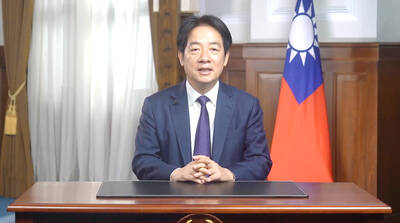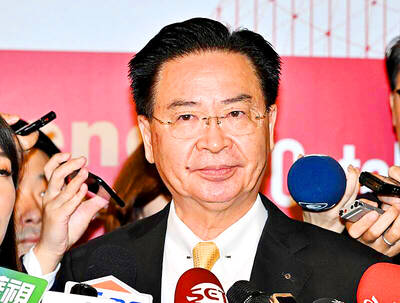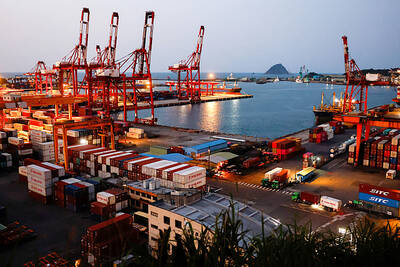Premier Chang Chun-hsiung (張俊雄) lashed out at the Taiwan Power Company (Taipower, 台電) yesterday during his inspection of the Third Nuclear Power Plant (核三廠) in Pingtung County, saying that the real cause of a recent fire at the plant was the company's failure to pay attention.
Chang said that Taipower officials had lacked sufficient awareness of possible dangers after learning that salt crystals had affected transmission lines connecting the plant to remote high voltage towers on March 17.
Two electric generators at the plant came to a stop because of transmission problems.
Taipower's slowness in fixing the transmission problems, however, indirectly resulted in a fire on March 18 at the plant, which caused damage to an electric generator. The Atomic Energy Council (AEC) ranked the accident the worst of its kind in Taiwan's history.
On March 21, the Cabinet established an independent task force, led by National Science Council Chairman Wei Che-ho (魏哲和), to investigate last weekend's incidents at the plant . The taskforce members carried out their first inspection of the plant yesterday.
"It's time for Taipower to establish people's confidence in the company," Chang said.
Chang said that it would be irresponsible of Taipower to continue to ignore its "lax management" because most nuclear accidents which have occurred worldwide can be attributed to human error.
"Taipower has a responsibility to the lives and property of 23 million people in Taiwan," he said.
Taipower President Kuo Junne-huey (
Chang also demanded that Taipower officials carry out safety checks at the two other operational nuclear plants, both in Taipei County.
In addition to the Cabinet's task force, three other groups -- one from Taipower and two from the AEC, one of which is independent and includes experts from outside the AEC -- have been working on their investigations simultaneously.
Anti-nuclear activists, meanwhile, are far from satisfied with the government's investigation. They think existing nuclear safety regulation systems should be reviewed.
"The local monitoring network established by local residents, rescue teams and fire departments did not function adequately during the recent accident because Taipower officials at the plant procrastinated for at least one hour before reporting the accident," Lai Wei-chieh (賴偉傑), secretary-general of the Green Citizens' Action Alliance, told the Taipei Times.

US President Donald Trump yesterday announced sweeping "reciprocal tariffs" on US trading partners, including a 32 percent tax on goods from Taiwan that is set to take effect on Wednesday. At a Rose Garden event, Trump declared a 10 percent baseline tax on imports from all countries, with the White House saying it would take effect on Saturday. Countries with larger trade surpluses with the US would face higher duties beginning on Wednesday, including Taiwan (32 percent), China (34 percent), Japan (24 percent), South Korea (25 percent), Vietnam (46 percent) and Thailand (36 percent). Canada and Mexico, the two largest US trading

ACTION PLAN: Taiwan would expand procurement from the US and encourage more companies to invest in the US to deepen bilateral cooperation, Lai said The government would not impose reciprocal tariffs in retaliation against US levies, President William Lai (賴清德) said yesterday, as he announced five strategies to address the issue, including pledging to increase Taiwanese companies’ investments in the US. Lai has in the past few days met with administrative and national security officials, as well as representatives from various industries, to explore countermeasures after US President Donald Trump on Wednesday last week announced a 32 percent duty on Taiwanese imports. In a video released yesterday evening, Lai said that Taiwan would not retaliate against the US with higher tariffs and Taiwanese companies’ commitments to

‘SPECIAL CHANNEL’: Taipei’s most important tasks are to stabilize industries affected by Trump’s trade tariffs and keep negotiations with Washington open, a source said National Security Council Secretary-General Joseph Wu (吳釗燮) arrived in the US for talks with US President Donald Trump’s administration, a source familiar with the matter said on Friday. Wu was leading a delegation for a meeting known as the “special channel,” the Financial Times reported earlier. It marked Trump’s first use of the channel since returning to the White House on Jan. 20. Citing a source familiar with the matter, the Financial Times reported that Minister of Foreign Affairs Lin Chia-lung (林佳龍) was also a part of the delegation. The visit came days after China concluded war games around Taiwan and amid Trump’s

CHIP EXCEPTION: An official said that an exception for Taiwanese semiconductors would have a limited effect, as most are packaged in third nations before being sold The Executive Yuan yesterday decried US President Donald Trump’s 32 percent tariff on Taiwanese goods announced hours earlier as “unfair,” saying it would lodge a representation with Washington. The Cabinet in a statement described the pledged US tariffs, expected to take effect on Wednesday next week, as “deeply unreasonable” and “highly regrettable.” Cabinet spokeswoman Michelle Lee (李慧芝) said that the government would “lodge a solemn representation” with the US Trade Representative and continue negotiating with Washington to “ensure the interests of our nation and industries.” Trump at a news conference in Washington on Wednesday announced a 10 percent baseline tariff on most goods